Dill
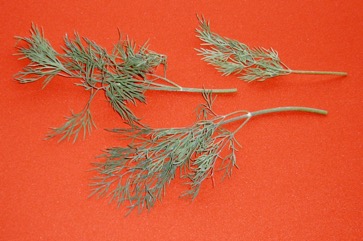
It is a temperate plant. It is suited to shady places but does best in sunny positions. It is easily damaged by wind. It is frost resistant but drought tender. It needs moist, well drained, humus rich soil. In hot weather it produces flowers quickly. It is best with temperatures of 16-18°C. A pH of 5.6-6.5 is best. It grows below 1,900 m above sea level. It can grow in arid places. It suits hardiness zones 8-10. In Sichuan.
Also known as:
Adas china, Adas manis, Adas sowa, Anis aleman, Anithi, BaqdonisDercotu, Dereotu, Ender, Enduro, Eneldo, Lubicha, Masala, Navadni koper, Phak chee lao, Phak si, Sowa arxa, Soya, Suwa, Tereotu, Ukrop, Yabani dere otu, Zanrkay
Synonyms
- Anethum sowa Roxb.
- Peucedanum graveolens (L.) Hiern.
- Peucedanum sowa Kurz.
Edible Portion
- Leaves, Seeds, Fruit, Herb, Spice, Vegetable
Where does Dill grow?
Found in: Afghanistan, Africa, Argentina, Asia, Australia, Bahamas, Bahrain, Brazil, Britain, Canada, Caucasus, Chile, China, Cook Islands, Cuba, Dominican Republic, East Africa, East Timor, Egypt, Ethiopia, Europe, France, Georgia, Ghana, Greece, Haiti, Hawaii, Himalayas, India, Indochina, Indonesia, Iran, Iraq, Israel, Italy, Jamaica, Japan, Jordan, Kenya, Kyrgyzstan, Laos, Lebanon, Lesser Antilles, Libya, Lithuania, Macedonia, Malaysia, Marquesas, Mediterranean, Mozambique, Myanmar, Nepal, Niger, Nigeria, North Africa, North America, Pacific, Pakistan, Palestine, Papua New Guinea, PNG, Philippines, Portugal, Puerto Rico, Qatar, Saudi Arabia, SE Asia, Serbia, Slovenia, South Africa, Southern Africa, South America, Spain, Sri Lanka, Sudan, Syria, Tajikistan, Tanzania, Tasmania, Thailand, Timor-Leste, Turkey, United Arab Emirates, UAE, United States, Vietnam, Virgin Islands, West Africa, West Indies, Zimbabwe
Notes: There are 2 (4) Anethum species.
Status: It is sold in markets. In Papua New Guinea not yet widely grown or used. It is a cultivated herb.
Growing Dill
Cultivation: Plants are grown from seed. They are not easily transplanted. Seed are therefore best sown where they are to grow. Seed should be 1 cm deep and with 25 cm between plants. (Dill and fennel can cross pollinate.)
Edible Uses: The seeds are used to flavour foods. They are added to pickles. The young leaves can be eaten. They have an aniseed flavour and are used in soups, salads, sauces, and with vegetables. The flowers are also used. It is one of the main ingredients in curry powder. The leaves and seeds are used for tea.
Production: Plants are fast growing. The leaves can be cut for use at any time, but they are at their best just before flowering. Plants can be cut 6 weeks after planting. Seeds are harvested when the plants are mature and have finished flowering and the fruits are fully formed. Harvesting during the cool of morning or evening avoids seeds being shattered and lost.
Nutrition Info
per 100g edible portion| Edible Part | Energy (kcal) | Protein (g) | Iron (mg) | Vitamin A (ug) | Vitamin c (mg) | Zinc (mg) | % Water |
|---|---|---|---|---|---|---|---|
| Seed | 305 | 16 | 16.3 | 5 | 21 | 5.2 | 7.7 |
| Leaves - dried | 253 | 20 | 48.8 | 585 | 50 | 3.3 | 7.3 |
| Leaves - fresh | 43 | 3.5 | 6.6 | 772 | 85 | 0.9 | 86 |
Dill Photos

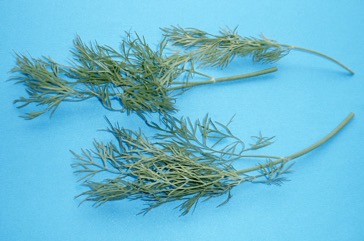
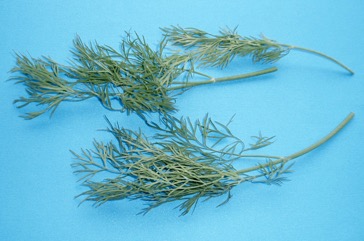
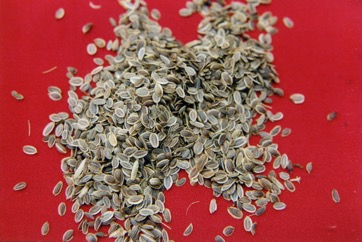
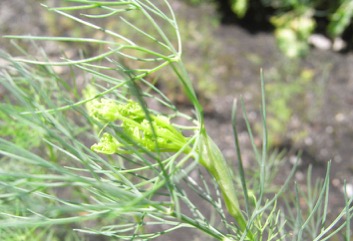
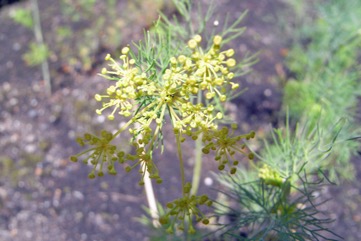
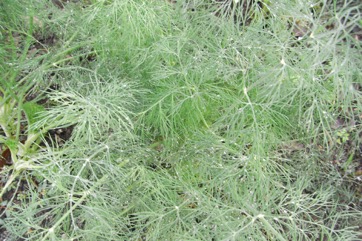
References
Ambasta S.P. (Ed.), 2000, The Useful Plants of India. CSIR India. p 41
Arora, R. K., 2014, Diversity in Underutilized Plant Species - An Asia-Pacific Perspective. Bioversity International. p 100
Berihun, T. & Molla, E., 2017, Study on the Diversity and Use of Wild Edible Plants in Bullen District Northwest Ethiopia. Hindawi Journal of Botany. Article ID 8383468
Bernholt, H. et al, 2009, Plant species richness and diversity in urban and peri-urban gardens of Niamey, Niger. Agroforestry Systems 77:159-179
Bianchini, F., Corbetta, F., and Pistoia, M., 1975, Fruits of the Earth. Cassell. p 100
Bircher, A. G. & Bircher, W. H., 2000, Encyclopedia of Fruit Trees and Edible Flowering Plants in Egypt and the Subtropics. AUC Press. p 28
Blamey, M and Grey-Wilson, C., 2005, Wild flowers of the Mediterranean. A & C Black London. p 158 (As Peucedanum anisum)
Bodkin, F., 1991, Encyclopedia Botanica. Cornstalk publishing, p 82 (Also as Peucedanum graveolens p 788)
Bremness, L., 1994, Herbs. Collins Eyewitness Handbooks. Harper Collins. p 229
Brickell, C. (Ed.), 1999, The Royal Horticultural Society A-Z Encyclopedia of Garden Plants. Convent Garden Books. p 118
Brown, D., 2002, The Royal Horticultural Society encyclopedia of Herbs and their uses. DK Books. p 121
Burkill, H. M., 1985, The useful plants of west tropical Africa, Vol. 1. Kew.
Burkill, I.H., 1966, A Dictionary of the Economic Products of the Malay Peninsula. Ministry of Agriculture and Cooperatives, Kuala Lumpur, Malaysia. Vol 1 (A-H) p 158
Burnie, G & Fenton-Smith, J., 1999, A Grower's Guide to Herbs. Murdoch Books. p 30
Bussman, R. W., et al, 2016, A comparative ethnobotany of Khevsureti, Samtskhe-Javakheti, Tusheti, Svaneti, and Racha-Lechkhumi, Republic of Georgia (Sakartvelo), Caucasus. Journal of Ethnobiology and Ethnomedicine (2016) 12:43
Bussman, R. W. et al, 2017, Ethnobotany of Samtskhe-Javakheti, Sakartvelo (Republic of Georgia), Caucasus. Indian Journal of Traditional Knowledge Vol. 16(1) pp 7-24
Cheifetz, A., (ed), 1999, 500 popular vegetables, herbs, fruits and nuts for Australian Gardeners. Random House p 114
Cundall, P., (ed.), 2004, Gardening Australia: flora: the gardener's bible. ABC Books. p 154
Dogan, Y., et al, 2004, The Use of Wild Edible Plants in Western and Central Anatolia (Turkey). Economic Botany 58(4) pp. 684-690
Dogan, A., et al, 2014, A review of edible plants on the Turkish Apiaceae species. J. Fac. Pharm. Istanbul, 44(2) pp 251-262
Dogan, Y., 2012, Traditionally used wild edible greens in the Aegean Region of Turkey. Acta Societatis Botanicorum Poloniae 81(4): 329-342
Dogan, Y. et al, 2013, Wild Edible Plants sold in the Local Markets of Izmir, Turkey Pak. J. Bot. 45(S1): 177-184
Ertug, F, Yenen Bitkiler. Resimli Türkiye Florası -I- Flora of Turkey - Ethnobotany supplement
Esperanca, M. J., 1988. Surviving in the wild. A glance at the wild plants and their uses. Vol. 1. p 310
Facciola, S., 1998, Cornucopia 2: a Source Book of Edible Plants. Kampong Publications, p 14
Farooq, S., et al, 2012, Ethnobotanical Studies of the Flora of Tehsil Birmal in South Waziristan Agency, Pakistan. Pak. J. Weed Sci. Res. 18(3): 277-291
Flora of Pakistan. www.eFloras.org
French, B., 1986, Food Plants of Papua New Guinea, Asia Pacific Science Foundation p 310
Gouldstone, S., 1983, Growing your own Food-bearing Plants in Australia. Macmillan p 188
Gunes, S. et al, 2018, Survey of wild food plants for human consumption in Karaisali (Adana-Turkey). Indian Journal of Traditional Knowledge. Vol. 17(2), April 2018, pp 290-298
Gurdal, B. & Kultur, S., 2014, The edible and miscellaneous useful plants in Marmaris (Southwest Turkey). İstanbul Ecz. Fak. Derg. / J. Fac. Pharm. Istanbul 44(1) 2014 pp.69-78
Hancer, C. K., et al, 2020, Traditional Knowledge of Wild Edible Plants of Biga (Çanakkale), Turkey. Acta Societatis Botanicorum Poloniae / 2020 / Volume 89 / Issue 1 / Article 8914
Hedrick, U.P., 1919, (Ed.), Sturtevant's edible plants of the world. p 473 (As Peucedanum graveolens)
Hepper, E.N., 1993, Illustrated Encyclopedia of Bible Plants, IVP, England. p 132
Hu, Shiu-ying, 2005, Food Plants of China. The Chinese University Press. p 589
Janaćković, P. et al, 2019, Traditional knowledge on plant use from Negotin Krajina (Eastern Serbia): An ethnobotanical study. Indian Journal of Traditional Knowledge Vol 18 (1), pp 25-33
Japanese International Research Centre for Agricultural Science www.jircas.affrc.go.jp/project/value_addition/Vegetables
Khodram,S. D., et al, 2019, Local knowledge of edible flowers used in Mizoram. Indian Journal of Traditional Knowledge Vol 18(40 pp 715-723
Kiple, K.F. & Ornelas, K.C., (eds), 2000, The Cambridge World History of Food. CUP p 433, 1768
Kybal, J., 1980, Herbs and Spices, A Hamlyn Colour Guide, Hamlyn Sydney p 32
Lazarides, M. & Hince, B., 1993, Handbook of Economic Plants of Australia, CSIRO. p 20
Marandi, R. R. & Britto, S. J., 2015, Medicinal Properties of Edible Weeds of Crop Fields and Wild plants Eaten by Oraon Tribals of Latehar District, Jharkhand. International Journal of Life Science and Pharma Research. Vo. 5. (2) April 2015
Martin, F.W. & Ruberte, R.M., 1979, Edible Leaves of the Tropics. Antillian College Press, Mayaguez, Puerto Rico. p 101, 220
Molla, A., Ethiopian Plant Names. http://www.ethiopic.com/aplants.htm
Mukemre, M., et al, 2016, Survey of wild food plants for human consumption in villages of Catak, (Van-Turkey), Indian Journal of Traditional Knowledge. Vol. 15(2) pp. 183-191
Norrington, L., & Campbell, C., 2001, Tropical Food Gardens. Bloomings Books. p 63
Norton, J., et al, 2009, An Illustrated Checklist of the Flora of Qatar. UNESCO Office in Doha.
Ochse, J. J. et al, 1931, Vegetables of the Dutch East Indies. Asher reprint. p 697
Oran, S. A. S., 2015, Selected Wild Aromatic Plants in Jordan. International Journal of Medicinal Plants. Photon 108 (2015) 686-699
Özdemir, E. and Kültür, S., 2017, Wild Edible Plants of Savaştepe District (Balıkesir, Turkey), Marmara Pharm J 21/3: 578-589
Plants for a Future database, The Field, Penpol, Lostwithiel, Cornwall, PL22 0NG, UK. http://www.scs.leeds.ac.uk/pfaf/
Plants of Haiti Smithsonian Institute http://botany.si.edu
Purseglove, J.W., 1968, Tropical Crops Dicotyledons, Longmans. p 648
Rivera, D. et al, 2006, Gathered Mediterranean Food Plants - Ethnobotanical Investigations and Historical Development, in Heinrich M, Müller WE, Galli C (eds): Local Mediterranean Food Plants and Nutraceuticals. Forum Nutr. Basel, Karger, 2006, vol 59, pp 18–74
Royal Botanic Gardens, Kew (1999). Survey of Economic Plants for Arid and Semi-Arid Lands (SEPASAL) database. Published on the Internet; http://www.rbgkew.org.uk/ceb/sepasal/internet [Accessed 13th June 2011]
Seidemann J., 2005, World Spice Plants. Economic Usage, Botany, Taxonomy. Springer. p 40
Solomon, C., 2001, Encyclopedia of Asian Food. New Holland. p 121
Sp. pl. 1:263. 1753
Staples, G.W. and Herbst, D.R., 2005, A tropical Garden Flora. Bishop Museum Press, Honolulu, Hawaii. p 113 (Drawing)
Terra, G.J.A., 1973, Tropical Vegetables. Communication 54e Royal Tropical Institute, Amsterdam, p 25
Tindall, H.D., 1983, Vegetables in the Tropics, Macmillan p 398
Tronickova, E. & Krejcova, Z., 1987, Ortaggi, Instituto Geografico de Agostini, Cecoslovacchia. p 188
Tyagi, R. K., et al, 2004, Conservation of Spices Germplasm in India. Indian J. Plant Genet. Resour. 17(3): 163-174
van Wyk, B., 2005, Food Plants of the World. An illustrated guide. Timber press. p 59
Vlkova, M., et al, 2015, Edible Plants Sold on Marginal Rural Markets in Fergana Valley, Southern Kyrgyzstan. Bulgarian Journal of Agricultural Science, 21 (No 2) 2015, 243–250
Woodward, P., 2000, Asian Herbs and Vegetables. Hyland House. p 22
World Checklist of Useful Plant Species 2020. Royal Botanic Gardens, Kew
Youssef, R. S. A., 2013, Medicinal and non-medicinal uses of some plants found in the middle region of Saudi Arabia. Journal of Medicinal Plants Research. Vol. 7(34), pp. 2501-2517